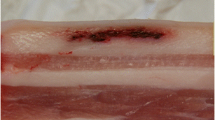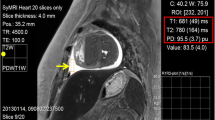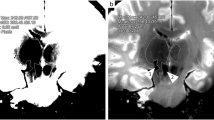Abstract
In clinical forensic medicine, hematomas and other externally visible injuries build the basis for the reconstruction of events. However, dating of subcutaneous hematomas based on their external aspect is difficult. Magnetic resonance imaging (MRI) has proven its use in dating intracranial hemorrhage. Thus, the aim was to investigate if MRI can also be used for dating subcutaneous hematomas and to analyze an eventual influence of the hematoma shape. In 20 healthy volunteers (11 females, 9 males, aged 26.9 ± 3.8 years), 4 ml of autologous blood were injected subcutaneously in the thigh. The hematoma was scanned immediately after the injection, after 3 and 24 h and 3, 7, and 14 days using three sequences with different contrast. Data was analyzed by measuring signal intensities of the hematoma, the muscle, and the subcutaneous tissue over time, and the Michelson contrast coefficients between the tissues were calculated. In the analysis, hematoma shape was considered. Signal intensity of blood in the proton density-weighted sequence reached its maximum 3 h after the injection with a subsequent decrease, whereas the signal intensities of muscle and fatty tissue remained constant. The time course of the Michelson coefficient of blood versus muscle decreased exponentially with a change from hyperintensity to hypointensity at 116.9 h, depending on hematoma shape. In the other sequences, either variability was large or contrast coefficients stayed constant over time. The observed change of contrast of blood versus muscle permits a quick estimate of a hematoma’s age. The consideration of the hematoma shape is expected to further enhance dating using MRI.






Similar content being viewed by others
References
Gomori JM, Grossman RI, Goldberg HI, Zimmerman RA, Bilaniuk LT (1985) Intracranial hematomas: imaging by high-field MR. Radiology 157(1):87–93
Zyed A, Hayman LA, Bryan RN (1991) MR imaging of intracerebral blood: diversity in the temporal pattern at 0.5 and 1.0 T. AJNR Am J Neuroradiol 12(3):469–474
Hayman LA, McArdle CB, Taber KH, Saleem A, Baskin D, Lee HS, Kirkpatrick JB, Herrick RC, Bryan RN (1989) MR imaging of hyperacute intracranial hemorrhage in the cat. AJNR Am J Neuroradiol 10(4):681–686
Bradley WG Jr (1993) MR appearance of hemorrhage in the brain. Radiology 189(1):15–26
Hayman LA, Taber KH, Ford JJ, Bryan RN (1991) Mechanisms of MR signal alteration by acute intracerebral blood: old concepts and new theories. AJNR Am J Neuroradiol 12(5):899–907
Allkemper T, Tombach B, Schwindt W, Kugel H, Schilling M, Debus O, Mollmann F, Heindel W (2004) Acute and subacute intracerebral hemorrhages: comparison of MR imaging at 1.5 and 3.0 T—initial experience. Radiology 232(3):874–881. doi:10.1148/radiol.2323030322
Bradley WGJ, Schmidt PG (1985) Effect of methemoglobin formation on the MR appearance of subarachnoid hemorrhage. Radiology 156(1):99–103
Hayman LA, Taber KH, Ford JJ, Saleem A, Gurgun M, Mohamed S, Bryan RN (1989) Effect of clot formation and retraction on spin-echo MR images of blood: an in vitro study. AJNR Am J Neuroradiol 10(6):1155–1158
Swensen SJ, Keller PL, Berquist TH, McLeod RA, Stephens DH (1985) Magnetic resonance imaging of hemorrhage. AJR Am J Roentgenol 145(5):921–927
Bush CH (2000) The magnetic resonance imaging of musculoskeletal hemorrhage. Skelet Radiol 29(1):1–9
Rubin JI, Gomori JM, Grossman RI, Gefter WB, Kressel HY (1987) High-field MR imaging of extracranial hematomas. AJR Am J Roentgenol 148(4):813–817
Spielmann RP, Maas R, Neumann C, Dallek M, Nicolas V, Heller M, Bucheler E (1990) MRT of acute soft tissue hematomas at 1.5 T: animal experimental results. Röfo 153(4):395–399. doi:10.1055/s-2008-1033402
Spielmann RP, Triebel HJ, Maas R, Langkowski J, Franz P, Heller M, Bucheler E (1989) MRT of extracranial hematomas at 1.5 T using spin echo and gradient echo sequences. Röfo 150(4):449–453. doi:10.1055/s-2008-1047054
Malli N, Ehammer T, Yen K, Scheurer E (2013) Detection and characterization of traumatic scalp injuries for forensic evaluation using computed tomography. Int J Legal Med 127(1):195–200. doi:10.1007/s00414-012-0690-x
Yen K, Vock P, Tiefenthaler B, Ranner G, Scheurer E, Thali MJ, Zwygart K, Sonnenschein M, Wiltgen M, Dirnhofer R (2004) Virtopsy: forensic traumatology of the subcutaneous fatty tissue; multislice computed tomography (MSCT) and magnetic resonance imaging (MRI) as diagnostic tools. J Forensic Sci 49(4):799–806
Neumayer B, Hassler E, Widek T, Petrovic A, Scheurer E (2012) Modelling of contrast changes in soft tissue hematomas. 29th Annual Meeting ESMRMB, Lisbon, pp 4–6
Hassler E, Neumayer B, Petrovic A, Ogris K, Widek T, Yen K, Scheurer E (2012) Contrast evaluation of artificial hematomas in different MRI sequences over time. 29th Annual Meeting ESMRMB, Lisbon, pp 4–6
Ogris K, Hassler EM, Petrovic A, Neumayer B, Widek T, Scheurer E (2014) Evaluation of impact factors in the regeneration process of hematomas in the subcutaneous fatty tissue. Joint Annual Meeting of the ISMRM and ESMRMB, Milan, pp 10–16
Michelson A (1927) Studies in optics. U. of Chicago Press, Chicago
Pilling ML, Vanezis P, Perrett D, Johnston A (2010) Visual assessment of the timing of bruising by forensic experts. J Forensic Legal Med 17(3):143–149. doi:10.1016/j.jflm.2009.10.002
Langlois NE, Gresham GA (1991) The ageing of bruises: a review and study of the colour changes with time. Forensic Sci Int 50(2):227–238
Hughes VK, Ellis PS, Langlois NE (2004) The perception of yellow in bruises. J Clin Forensic Med 11(5):257–259. doi:10.1016/j.jcfm.2004.01.007
Stephenson T, Bialas Y (1996) Estimation of the age of bruising. Arch Dis Child 74(1):53–55
Randeberg LL, Haugen OA, Haaverstad R, Svaasand LO (2006) A novel approach to age determination of traumatic injuries by reflectance spectroscopy. Lasers Surg Med 38(4):277–289. doi:10.1002/lsm.20301
Petrovic A, Diwoky C, Hassler E, Ogris K, Scheurer E (2013) IDEAL fat-water separation for the detection and characterization of subcutaneaous hemorrhage. 21st Annual Meeting ISMRM, Salt Lake City
Chu B, Kampschulte A, Ferguson MS, Kerwin WS, Yarnykh VL, O’Brien KD, Polissar NL, Hatsukami TS, Yuan C (2004) Hemorrhage in the atherosclerotic carotid plaque: a high-resolution MRI study. Stroke 35(5):1079–1084. doi:10.1161/01.STR.0000125856.25309.86
Unger EC, Glazer HS, Lee JK, Ling D (1986) MRI of extracranial hematomas: preliminary observations. AJR Am J Roentgenol 146(2):403–407
Yamashita Y, Hatanaka Y, Torashima M, Takahashi M (1995) Magnetic resonance characteristics of intrapelvic haematomas. Br J Radiol 68(813):979–985
Author information
Authors and Affiliations
Corresponding author
Rights and permissions
About this article
Cite this article
Hassler, E.M., Ogris, K., Petrovic, A. et al. Contrast of artificial subcutaneous hematomas in MRI over time. Int J Legal Med 129, 317–324 (2015). https://doi.org/10.1007/s00414-014-1124-8
Received:
Accepted:
Published:
Issue Date:
DOI: https://doi.org/10.1007/s00414-014-1124-8




